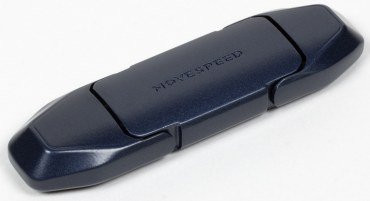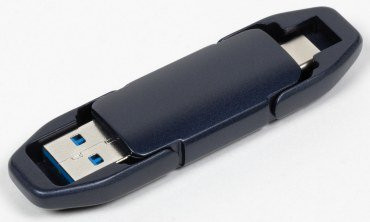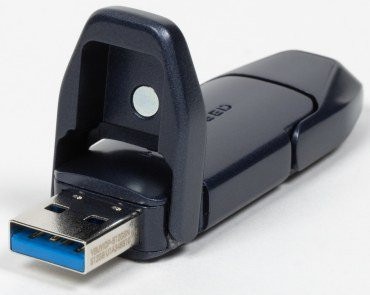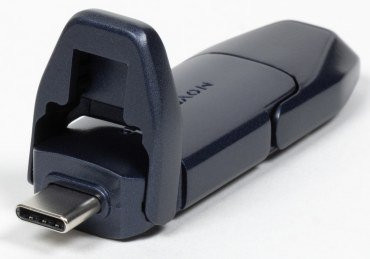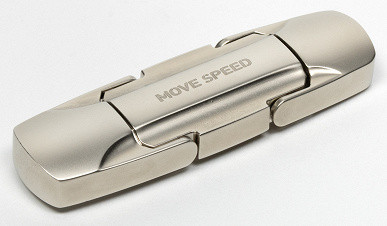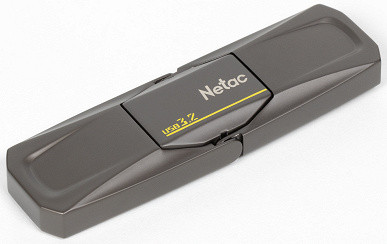Returning to the testing of «fast flash drives», we have already exhausted many topics. For example, UFS drives turned out to be more preferable compared to traditional USB flash drives with improved characteristics, but they do not require further study. All of these devices use the same USB-UFS bridge JMicron JMS901, which was developed in the last decade and does not support USB 3.0 Gen2. This limitation is not so critical for regular flash drives, but for fast models it still affects the results. Some Chinese manufacturers resort to marketing tricks to promote such products, as we recently discussed.
MoveSpeed 2 in 1 is a decent UFS drive with an excellent design and support for the Trim command (which is rare for such devices). However, the manufacturer indicated support for USB 3.0 Gen2 and speeds up to 520 MB / s on the package, which is false, since in fact these characteristics do not correspond to reality. Therefore, after the purchase, it is useful to open a dispute on the AliExpress platform and request a discount due to the discrepancy between the declared characteristics. This allows you to significantly reduce the price, making the flash drive not only high-quality, but also affordable.
Manufacturers who want to declare high speeds without deception actually have no choice. They can use budget SATA SSDs in a flash drive case and honestly declare support for USB 3.0 Gen2 and speeds up to 550 MB/s. An additional bonus is that such a device can be cheaper. However, modern budget SATA SSDs show good results only when working with SLC cache, and in real conditions, speeds can drop to the level of USB 2.0 when writing large amounts of data. External UFS flash drives do not suffer from this, maintaining speeds above 100 MB/s.
In addition, peak USB-SATA speeds are no longer surprising, since SATA uses only half the bandwidth of USB 3.0 Gen2. Switching to USB-NVMe is logical, but it is more expensive and requires more space. For those looking for terabytes of capacity and gigabyte per second speeds, the best option is to build your own external SSD. M.2 2230 and the appropriate cases allow you to create a compact drive, but for larger capacities you will need a larger case and a cable that takes up more space than the drive itself.
Another option is to use modern flash controllers, which we have already mentioned. Controllers such as Silicon Motion SM2320 and Phison U17/U18 are similar to budget SSD solutions, but support USB 3.2 Gen2 or USB 3.2 Gen2x2 with throughput up to 10 or 20 Gbps. They do not require a bridge, which makes them more compact and cheaper.
However, these controllers have their drawbacks. They are usually in the budget segment, so they do not provide the performance of a high-end SSD. Many manufacturers prefer to release large external SSDs with a separate cable, which makes them more reliable in the eyes of consumers, but reduces the potential compactness. However, there are successful examples of compact solutions, which we will look at today. At first, it seemed that MoveSpeed did not take advantage of this opportunity, but a deeper study showed that the problem is not with the final manufacturer, but with the Silicon Motion controllers. All products on this platform suffer from the same problem, which requires careful consideration.
Silicon Motion SM2320 and Write Speed
Let's take a look at the current state of the Silicon Motion controller family, which grew out of a single model. Initially, the SM2320 was introduced — a four-channel bufferless controller designed for external SSDs with a USB 3.2 Gen2×2 interface, providing a throughput of 20 Gbps, which corresponds to about 2 GB/s in real conditions. The SM2320 is capable of realizing this speed, but not always. Like many budget SSD controllers, its high write speed is only possible within the SLC cache. Outside the cache, the write speed can drop significantly, although reading remains stable.
Firmware with direct writing to TLC arrays is available for this platform, which provides good speed. However, most drives use old writing methods, due to which the speed drops after writing several tens or hundreds of gigabytes, reaching less than 200 MB/s. This behavior is observed in both internal and external SSDs.
Manufacturers have started using QLC instead of TLC to save money, although this is not a very common practice yet. For example, the Kingston XS1000 with a terabyte of QLC has already been spotted for sale. Despite this, the XS1000 works on the SM2320 controller. Formally, the SM2321 was introduced for inexpensive models with two flash channels instead of four and a smaller capacity of up to 2 TB. But in practice, the SM2321 does not exist separately — Silicon Motion simply blocks the capabilities of the old SM2320 to create a cheaper version. SM2322 has also appeared, identical to SM2320, but with a capacity of up to 8 TB, although its actual availability has not yet been confirmed.
All drives based on SM2320 face a problem: sometimes the write speed, even in the cache, can «get stuck» at a level slightly above 300 MB / s. At the same time, the read speed remains high, but the write slows down, despite the absence of errors.
This issue is common to all SM2320 platform drives, regardless of brand or device type. It is seen on Chinese models from MoveSpeed and Fanxiang, as well as international brands such as Adata and Kingston. All devices on this platform are at risk.
The issue does not seem to be specific to the operating system or specific chipsets, although it can be seen on all Intel chipsets starting from the 500 series and possibly earlier. AMD USB controllers show better stability, especially with USB4 support in the new mobile Ryzen 6000+. USB3 controllers on desktop platforms can also encounter this issue. The only thing we know for sure is that the issue occurs in normal work scenarios, not just in testing.
One way the issue manifests itself is with the AIDA64 write test, which can «lock» the write speed. After that, the issue persists until the drive is reconnected to a different USB port. This test is useful, but it is not the only factor, as the issue may manifest itself in other usage scenarios.
So the issue exists and may affect performance. A temporary solution may be related to a firmware update from Silicon Motion, although this needs to be confirmed. This review presents the test results in both normal and problematic modes of the device. The decision whether to risk using such drives is up to the user.
MoveSpeed 1000 MB/s 2 in 1 USB Flash Drive 512 GB
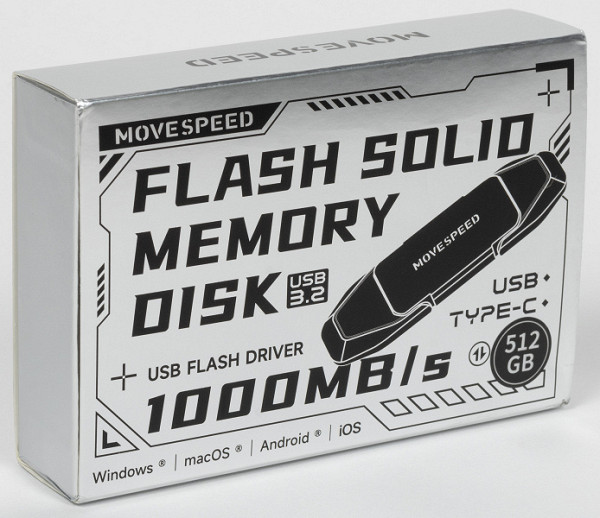
Many small Chinese companies, like many others, often lack quality marketers. It is a complex and creative profession, and it is not easy to find real specialists. Although many companies already know how to develop and produce quality products, promoting and selling these products remains a problem. Often, companies fail to come up with adequate names for their products and create confusion on platforms like AliExpress. New packaging and design often do not help to stand out, and the speed characteristic, for example, 1000 MB/s, may be indicated only for reading, while the write speed is declared only up to 800 MB/s and is only available on the website.

The set still includes a case with a key ring, which is not officially documented, so it passes as a gift — but they give it to everyone.
We praised the design last time, so we won't repeat ourselves. The only thing worth noting is that the connector covers have been slightly modified to improve the appearance. This has resulted in the drive's actual length being increased by half a centimeter, which is not reflected in the specifications.
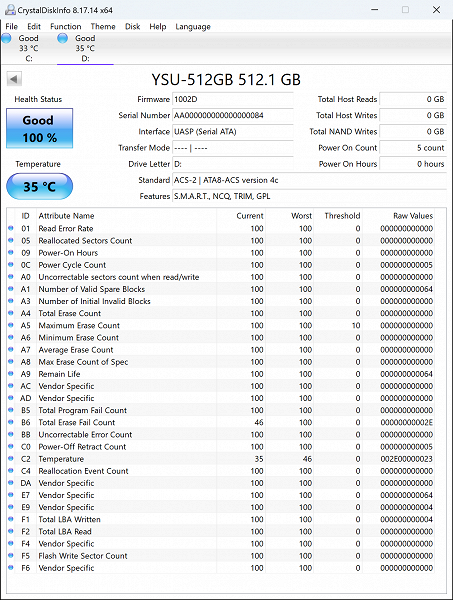
We are more interested in the internal contents of the device. Inside, we found a Silicon Motion SM2320 controller and 128-layer YMTC TLC memory with 512 Gb crystals. Interestingly, the crystals are combined into 1 Tb assemblies — these are probably leftovers from another order that were used for flash drives. In practice, given the operation of only two channels and the interface limitations, the controller could be considered SM2321, although it does not physically exist.
As for the platform, everything is clear with it. The read speed will be high, there are no problems with Trim support, and SMART is quite informative — these are clear advantages compared to UFS flash drives. Compared to full-size external SSDs in a flash drive case, the picture is less clear. Full-size models are not always better than compact solutions, but if you consider them within the framework of compact devices, you can assemble something faster if you do not adhere to compactness. This is especially true for models with a capacity of a terabyte, which cost a lot of money and require maximum speed. Today we will focus on compact solutions, where compactness may reduce speed a little, but not so much that it would be critical.
Testing
Testing methodology
For testing, we used a testbed based on the Intel Core i9-11900K processor and the Asus ROG Maximus XIII Hero motherboard with the Intel Z590 chipset, which provides support for all USB 3.2 modes, including USB3 Gen2×2.
The NTFS file system was used for all devices. Write caching was enabled for all drives that supported it. For flash drives, even high-speed ones, this is usually not supported, while for external SSDs and hard drives it is active. Ignoring caching is not recommended, as it can significantly affect performance.
Samples for comparison
We decided to test three devices: two MoveSpeed flash drives and one Netac. Despite their similar appearance, they are very different inside, representing three main concepts: UFS, SATA SSD via USB bridge and integrated top-end controller for flash drives. At the moment, integrated controllers look like the most promising direction, so we plan to study other devices in this category. Today, we will provide four sets of results, including tests for the “correct” and “incorrect” modes of the main character, so that the comparison of these modes is on par with the analysis of competitors.
Filling in data
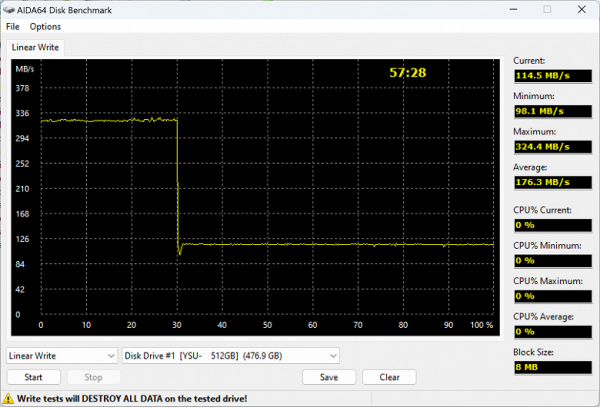
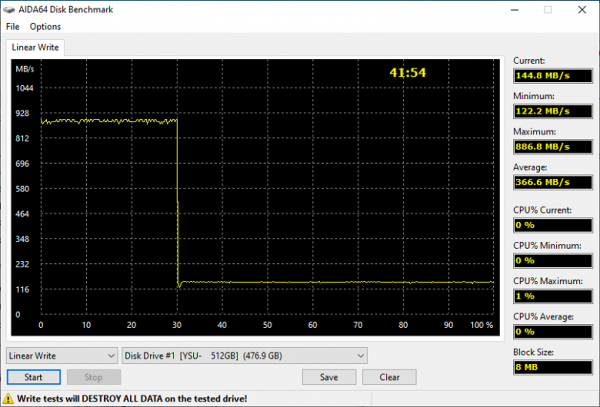
The first graph shows the expected performance, and the second one shows the real one, which, unfortunately, is often worse. The bulk of the data is written at a speed below 150 MB/s (if the disk were a terabyte, the speed would probably increase to 200 MB/s, but not more). However, even a quarter difference in speed is noticeable when it is not enough. The peak speed varies almost three times: in the standard mode, the flash drive shows results better than those declared by the manufacturer, and in the «wrong» mode, its performance may be inferior to models with a USB-SATA bridge. However, this is true until the cache runs out.
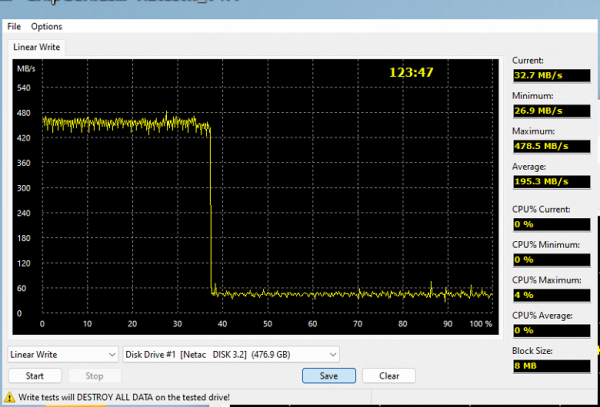
Direct comparison with Netac US5 shows that it writes to cache faster than the incorrectly working MoveSpeed 1000 MB/s, but writes «tails» much slower. As a result, the overall test execution time increases more than twofold. However, in «normal» mode, our hero of today leaves no chance for inexpensive models with a USB-SATA bridge.
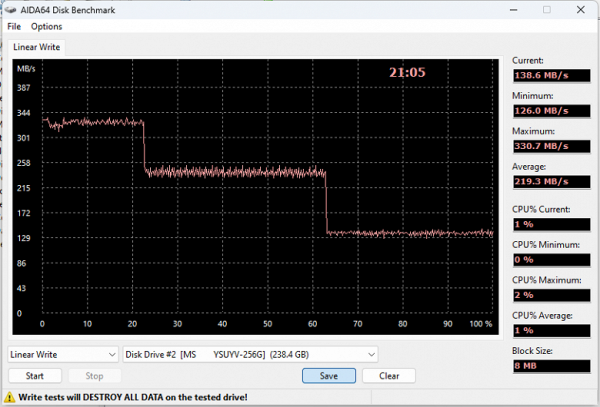
The UFS flash drive can complete the test significantly faster, thanks to its large direct write section (although the numbers on the graph may be more impressive due to different capacities). However, it is worth remembering that many UFS models have problems clearing the SLC cache due to incomplete Trim support, so this is the best possible scenario. Peak speeds of UFS flash drives are also limited and are minimal in today's top three. Even with the SM2320 «incorrectly» working, the speeds are about the same. Thus, flash drives like MoveSpeed 1000 MB/s represent an obvious step forward in terms of performance.
Working with large files
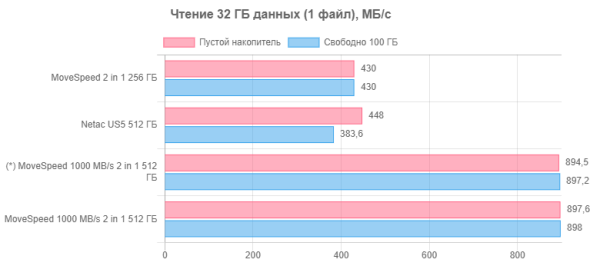
As mentioned, the only issues are writing, but reading remains stable as expected. So the real competitors are either similar products or external NVMe SSDs. Other platforms we are already familiar with are twice as slow.
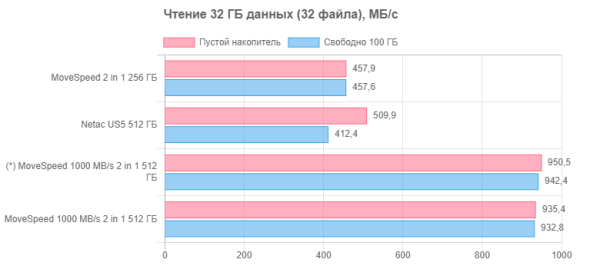
Multi-threaded mode for external storage is synthetic, but it is the results that manufacturers often advertise because they are the most impressive. Although we did not reach the full 1000 MB/s, we came as close as possible. It is important not only what numbers were obtained, but also who else can achieve such results. UFS flash drives are not suitable, since they require a new bridge with a faster external interface than USB3 Gen1. USB-SATA supports USB3 Gen2, but here the limiting factor is SATA. Thus, to fully realize the capabilities of USB3 Gen2, you need either USB-NVMe or a specialized controller, such as SM2320, which copes well with reading.
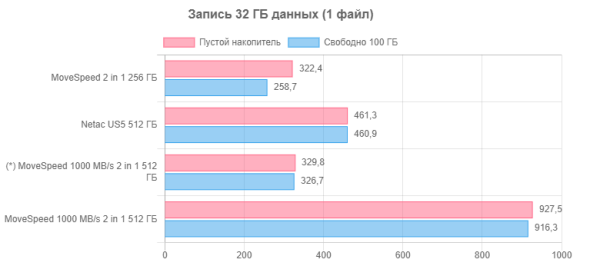
When writing, it is important to avoid the aforementioned performance issue. However, even in this case, the speed remains higher than that of UFS flash drives, since the test file fits entirely in the cache. The Netac US5 in first place also wins thanks to the cache, and we have already seen what happens when the cache fails. When competing with high-speed external SSDs, every detail matters, so you should not ignore possible performance issues. Flash drives based on the SM2320 can indeed be very fast in their class, but sometimes their speed can be lower than expected. Hopefully, Silicon Motion will fix this issue and eliminate the performance discrepancies.
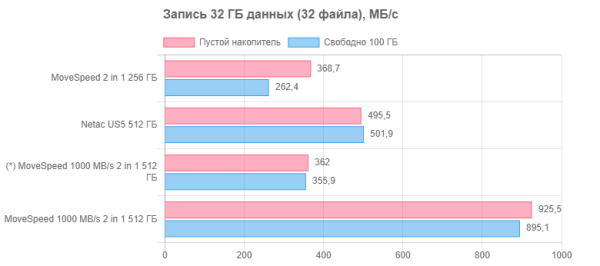
Since the internal mechanisms of SSD operation are the same in different scenarios, the results and conclusions remain unchanged. The main conclusion is that externally different «fast flashes» on this element base are also SSDs. Although they are not as powerful as the top models, they still outperform many SATA-SSDs, which are fundamentally slower.
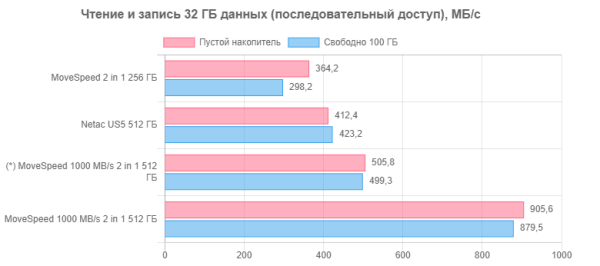
Limited data recording in problematic mode affects performance, but high read speed allows you to effectively complete the remaining work. It is better, of course, if the device works as intended, but in its current state it shows good results. This is especially noticeable when performing tasks such as unpacking a large archive directly on a flash drive, where such an operating mode is obvious.
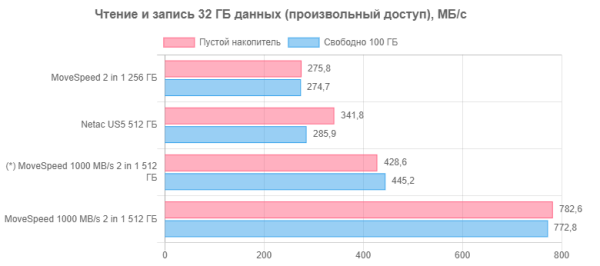
The most difficult scenario for external storage may be interface limitations. Fortunately, such situations are rare. For flash drives, the difference between sequential and random addressing (at reasonable block sizes, not degenerate synthetics like 4K) is usually not that significant, and the results can be comparable. In a research context, what is important is that such flash drives, even in the worst case, are faster than USB-UFS or USB-SATA. And if everything works as intended, they can be significantly faster.
Comprehensive performance
The best comprehensive benchmark for storage devices at the moment is PCMark 10 Storage, which is covered in detail in our review. We noted that of the three tests in the suite, the “full” Full System Drive is the most valuable, as it covers almost all typical usage scenarios: from booting the operating system to regular data copying. The other two tests are just subsets of this full test and, in our opinion, less interesting.
However, the full test is useful for accurately measuring not only the real throughput when performing practical tasks, but also latencies. Averaging these metrics and reducing them to a single number is a bit synthetic, but these are still closer to reality than individual cases. Although this method may seem redundant for evaluating even “full-size” and non-budget external SSDs, it remains relevant, especially for owners of inexpensive flash drives, which are used mainly as a faster alternative to regular flash drives. The read, write, and copy tests, as well as more complex scenarios included in the test suite, make this program extremely useful for a comprehensive evaluation of drives.
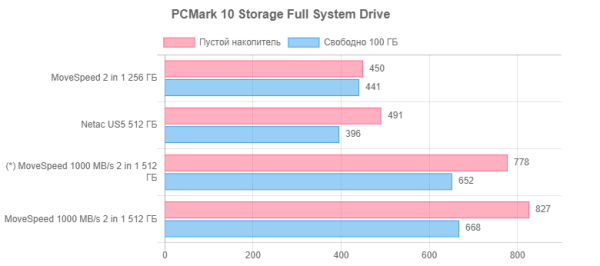
Netac US5 is not the best implementation of the USB-SATA concept, but there are no better options on the modern market, so it is not the worst choice. Regardless of the form factor, a large model with a wire inside is usually equipped with a similar budget controller and flash memory. In the worst case, QLC is used, in the best case — TLC, although budget controllers can level out these differences. Flash drives on the SM2320 controller are much faster. They work at the level of the best USB-SATA solutions that have long disappeared from the market in finished form, and assembling such a thing yourself no longer makes sense, since it will cost more than a more decent and faster USB-NVMe. It is important that any self-assemblies have a completely different level of compactness, and a flash drive of such dimensions cannot be assembled — here the only option is to buy a ready-made solution. Although a problem with the write speed may arise, this is not so critical, since most of the tests of this package are related to reading data, which is not subject to degradation. Nevertheless, checking specific numbers does not hurt, and that is why we did it.
Total
The emergence of flash drives with controllers like Silicon Motion SM2320 makes models with USB-UFS and USB-SATA bridges less relevant. The main difference is observed at the level of 10-gigabit USB 3.2 Gen 2, which older models cannot fully reveal, while specialized controllers like SM2320 cope with this task. This is a step forward in the development of technology. Whether a specific user needs it is a separate question. Flash drives are no longer a must-have purchase, and models claiming to be mass-produced are usually either small and slow, or very cheap. High-speed drives on modern controllers are much more expensive, so buying them “just in case” is not always justified.
While 20 years ago a gigabyte flash drive cost about 100 conventional units and had a read and write speed of about 10 MB/s, now for the same amount you can buy a drive 100 times faster and 1000 times more capacious. This is significant progress, but user needs have changed. However, the demand for such devices remains, and the offers are only getting better.
As for the specific model, the flash drive based on Silicon Motion SM2320 has typical advantages and disadvantages of such drives. For small companies working with AliExpress, there is a risk that the quality may vary. However, this is compensated by the price and other consumer characteristics. If you have doubts about buying through AliExpress, you can find similar devices in local stores. For example, the Adata Elite UE800, Kingston DataTraveler Max (although its design may raise questions due to the connectors) and Transcend ESD310. These models differ in the memory used and caching settings, which affects performance.
The choice of flash drives with the SM2320 controller or a similar one from Phison should be based on detailed testing and comparison, since each model has its own pros and cons. Prices and availability may change, so it is worth checking the current offers before buying. Overall, the SM2320 platform makes older USB-UFS and USB-SATA based solutions obsolete, but it also has some drawbacks, such as a possible decrease in write speed, which is a general issue for the platform rather than a specific model.

